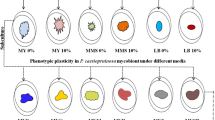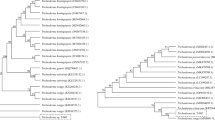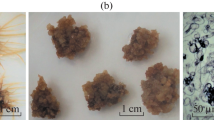Abstract
Lichen species have unique culture media preferences, and established cultures are known for the synthesis of secondary metabolites. This paper reports observations on the developmental stages and secondary compound biosynthesis by the mycobiont and whole thallus cultures of Buellia subsororioides. It also investigates the suitable media compositions for the culture growth, the role (nutrient or stressor) of sucrose concentrations on the growth stages, biomass, secondary compound profiles, and the quantity of biosynthesized known compounds/g of culture biomass for each treatment using mycobiont cultures. The ascospore-derived mycobiont cultures and thallus macerate-derived whole thallus cultures of B. subsororioides were established and grown using malt yeast extract (MY) medium. Mycobiont cultures were subcultured in MY medium supplemented with sucrose and its concentrations ranging from 0 to 30 % (with 2 % increment between treatments) for 120 days. The molecular identity of cultures was confirmed using nuclear ribosomal Internal transcribed spacer (ITS) DNA sequences obtained from the cultured mycobiont and from the natural thallus. The ITS DNA sequences of the mycobiont showed 99 % similarity with the sequences of the natural thallus. The mycobiont cultures under varying sucrose concentrations initiated as white cottony stages and transformed to brown compact mycelia, with optimum biomass and biosynthesis of nine secondary compounds in MY 10 %. The number of compounds (1–9) varies according to treatments. The whole thallus cultures (MY 0 %) showed a profile of secondary compounds similar to that of the natural thalli along with a trace of one unknown compound. The obtained results are encouraging for the synthesis of the desired quantities of lichen secondary compounds through cultures for relevant applications.






Similar content being viewed by others
Abbreviations
- NT:
-
Natural thallus
- MY:
-
Malt yeast extract medium
- MYC:
-
Mycobiont culture
- WTC:
-
Whole thallus culture
- UV:
-
Ultraviolet wavelength
- BA:
-
Baeomycesic acid
- NA:
-
Norstictic acid
- AT:
-
Atranorin
- HPTLC:
-
High performance thin layer chromatography
- ITS:
-
Internal transcribed spacer
- SE:
-
Standard error
References
Arup U, Ekman S, Lindblom L, Mattsson JE (1993) High performance thin layer chromatography (HPTLC), an improved technique for screening lichen substances. Lichenologist 25:61–71
Barry VC (1969) Synthetic phenazine derivatives and mycobacterial disease: a twenty year investigation. Sci Proc R Dublin Soc Ser A 3:153–170
Boustie J, Grube M (2005) Lichens—a promising source of bioactive secondary metabolites. Plant Genet Resour 3:273–287
Brunauer G, Hager A, Grube M, Türk R, Stocker-Wörgötter E (2007) Alterations in secondary metabolism of aposymbiotically grown mycobionts of Xanthoria elegans and cultured resynthesis stages. Plant Physiol Biochem 45:146–151
Chooi YH, Stalker DM, Davis MA, Fujii I, Elix JA, Louwhoff SHJJ, Lawrie AC (2008) Cloning and sequence characterization of a non-reducing polyketide synthase gene from the lichen Xanthoparmelia semiviridis. Mycol Res 112:147–161
Cordeiro LMC, Iacomini M, Stocker-Wörgötter E (2004) Culture studies and secondary compounds of six Ramalina species. Mycol Res 108:489–497
Crittenden PD, David JC, Hawksworth DL, Campbell FS (1995) Attempted isolation and success in the culturing of a broad spectrum of lichen-forming and lichenicolous fungi. New Phytol 130:267–297
Elix JA, Stocker-Wörgötter E (2008) Biochemistry and secondary metabolites. In: Nash TH III (ed) Lichen biology, 2nd edn. Cambridge University Press, Cambridge, pp 104–133
Elix JA, Jenie UA, Parker JL (1987) A novel synthesis of the lichen depsidones divaronic acid and stenosporonic acid, and the biosynthetic implications. Aust J Chem 40:1451–1464
Emmerich R, Giez I, Lange OL, Proksch P (1993) Toxicity and antifeedant activity of lichen compounds against the polyphagous herbivorous insect Spodoptera littoralis. Phytochemistry 33:1389–1394
Fazio AT, Bertoni MD, Adler MT, Ruiz LB, Rosso ML, Muggia L, Hager A, Stocker-Wörgötter E, Maier MS (2009) Culture studies on the mycobiont isolated from Parmotrema reticulatum (Taylor) Choisy: metabolite production under different conditions. Mycol Prog 8:359–365
Fazio AT, Adler MT, Maier MS (2014) Usnic acid and triacylglycerides production by the cultured lichen mycobiont of Ramalina celastri. Nat Prod Commun 9(2):213–214
Gardes M, Bruns TD (1993) ITS primers with enhanced specificity for basidiomycetes—application to the identification of mycorrhizae and rusts. Mol Ecol 2:113–118
Gargas A, Taylor JW (1992) Polymerase chain reaction (PCR) primers for amplifying and sequencing nuclear 18S rDNA from lichenized fungi. Mycologia 84:589–592
Guzow-Krzemińska B, Stocker-Wörgötter E (2013) In vitro culturing and resynthesis of the mycobiont Protoparmeliopsis muralis with algal bionts. Lichenologist 45:65–76
Hale ME (1973) Growth. In: Ahmadjian V, Hale ME (eds) The lichens. Academic Press, New York, London, pp 473–492
Hamada N (1993) Effects of osmotic culture conditions on isolated lichen mycobionts. Bryologist 96:569–572
Hamada N (1996) Induction of the production of lichen substances by non-metabolites. Bryologist 99:68–70
Hamada N, Miyagawa H, Miyawaki H, Inoue M (1996) Lichen substances in mycobionts of crustose lichens cultured on media with extra sucrose. Bryologist 99:71–74
Hametner C, Stocker-Wörgötter E (2015) Type I NR-PKS gene characterization of the cultured lichen mycobiont Xanthoparmelia substrigosa (Ascomycota). In: Upreti DK, Divakar PK, Shukla V, Bajpai R (eds) Recent advances in lichenology, chapter: 5. Springer, India, pp 95–111
Kinoshita K, Fukumaru M, Yamamoto Y, Koyama K, Takahashi K (2015) Biosynthesis of panaefluoroline B from the cultured mycobiont of Amygdalaria panaeola. J Nat Prod 78:1745–1747
Lal B, Upreti DK (1995) Ethnobotanical notes on three Indian lichens. Lichenologist 27:77–79
Le DH, Takenaka Y, Hamada N, Mizushina Y, Tanahashi T (2014) Polyketides from the cultured lichen mycobiont of a Vietnamese Pyrenula sp. J Nat Prod 77:1404–1412
Legaz ME, de Armas R, Vicente C (2011) Bioproduction of depsidones for pharmaceutical purposes. In: Rundfeld C (ed) Drug development—a case study based insight into modem strategies. InTech, Rijeka, Croatia, pp 487–508
Lilly VG, Barnett HL (1951) Physiology of the fungi. McGraw-Hill, New York
McDonald TR, Gaya E, Lutzoni F (2013) Twenty-five cultures of lichenizing fungi available for experimental studies on symbiotic systems. Symbiosis 59:165–171
Miao V, Coëffet-LeGal MF, Brown D, Sinnemann S, Donaldson G, Davies J (2001) Genetic approaches to harvesting lichen products. Trends Biotechnol 19:349–355
Molina MC, Divakar PK, González N (2015) Success in the isolation and axenic culture of Anaptychia ciliaris (Physciaceae, Lecanoromycetes) mycobiont. Mycoscience 56:351–358
Müller K (2001) Pharmaceutically relevant metabolites from lichens. Appl Microbiol Biotechnol 56:9–16
Nash TH III (2008) Lichen biology, 2nd edn. Cambridge University Press, Cambridge
Nolan TJ, Algar J, McCann EP, Monahan WA, Nolan N (1948) The chemical constituents of lichens found in Ireland. Buellia canescens. Part 3. The constitution of diploicin. Sci Proc R Dublin Soc 24:319–334
Orange A, James PW, White FJ (2001) Microchemical methods for the identification of lichens. British Lichen Society, London
Rafat A, Ridgway HJ, Cruickshank RH, Buckley HL (2015) Isolation and co-culturing of symbionts in the genus Usnea. Symbiosis 66(3):123–132
Rundel PW (1978) The ecological role of secondary lichen substances. Biochem Syst Ecol 6:157–170
Sangvichien E, Hawksworth DI, Whalley AJS (2011) Ascospore discharge, germination and culture of fungal partners of tropical lichens, including the use of a novel culture technique. IMA Fungus 2:143–153
Schatz A (1962) Pedogenic (soil-forming) activity of lichen acids. Naturwissenschaften 49:518–519
Singh SR, Awasthi DD (1981) The lichen genus Buellia in India. Biol Memoirs 6:169–196
Singh KP, Sinha GP (2010) Indian lichens: an annotated checklist. Botanical Survey of India, Kolkata
Stocker-Wörgötter E (2008) Metabolic diversity of lichen-forming ascomycetous fungi: culturing, polyketide and shikimate metabolite production, and PKS genes. Nat Prod Rep 25:188–200
Stocker-Wörgötter E, Elix JA (2006) Morphogenetic strategies and induction of secondary metabolite biosynthesis in cultured lichen-forming ascomycota, as exemplified by Cladia retipora (Labill.) Nyl. and Dactylina arctica (Richards) Nyl. Symbiosis 41:9–20
Takenaka Y, Naito Y, Le DH, Hamada N, Tanahashi T (2013) Napthoquinones and phenaleone derivatives from the cultured mycobiont of Trypethelium sp. Heterocycles 87:1897–1902
Timsina BA, Sorensen JL, Weihrauch D, Piercey-Normore MD (2013) Effect of aposymbiotic conditions on colony growth and secondary metabolite production in the lichen-forming fungus Ramalina dilacerata. Fungal Biol 117:731–743
Valarmathi R, Hariharan GN (2007) Soredial culture of Dirinaria applanata (Fée) Awasthi: observations on developmental stages and compound production. Symbiosis 43:137–142
Valarmathi R, Hariharan GN, Venkataraman G, Parida A (2009) Characterization of a non-reducing polyketide synthase gene from lichen Dirinaria applanata. Phytochemistry 70:721–729
White TJ, Bruns T, Lee S, Taylor J (1990) Amplification and direct sequencing of fungal ribosomal RNA genes for phylogenetics. In: Innis M, Gelfand D, Sninsky J, White T (eds) PCR protocols: a guide to methods and applications. Academic Press, New York, pp 315–322
Yoshimura I, Yamamoto Y, Nakano T, Finnie J (2002) Isolation and culture of lichen photobionts and mycobionts. In: Kranner I, Beckett RP, Varma AK (eds) Protocols in lichenology: culturing, biochemistry, ecophysiology and use in biomonitoring. Springer, Berlin, pp 3–33
Acknowledgments
We thank Prof. M.S. Swaminathan, Founder Chairman, and Dr. Ajay Parida, Executive Director, M.S. Swaminathan Research Foundation, for their constant encouragement and support; Dr Brian Coppins, Royal Botanic Garden Edinburgh, for correcting the language, Dr. G. Ganesan, C. Divya for suggestions, Mr. G.K. Dayanandham, Senior Secretary for his immense help in the final version of manuscript preparation and Mr. E. Siva for his help in the laboratory and Department of Biotechnology, Government of India, for the financial assistance.
Author information
Authors and Affiliations
Corresponding author
Additional information
Section Editior: Gerhard Rambold
Electronic supplementary material
Below are the links to the electronic supplementary material.
Supplementary Figure 1
(PDF 383 kb)
Supplementary Figure 2
(PDF 346 kb)
Supplementary Figure 3
(PDF 302 kb)
Supplementary Figure 4
(PDF 262 kb)
Supplementary Figure 5
(PDF 425 kb)
Supplementary Table 1
(PDF 329 kb)
Rights and permissions
About this article
Cite this article
Shanmugam, K., Srinivasan, M. & Hariharan, G.N. Developmental stages and secondary compound biosynthesis of mycobiont and whole thallus cultures of Buellia subsororioides . Mycol Progress 15, 41 (2016). https://doi.org/10.1007/s11557-016-1184-x
Received:
Revised:
Accepted:
Published:
DOI: https://doi.org/10.1007/s11557-016-1184-x




